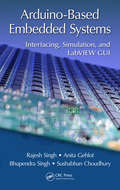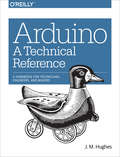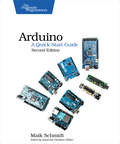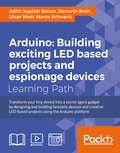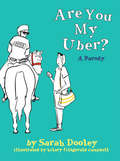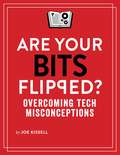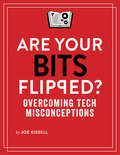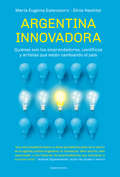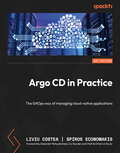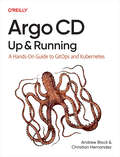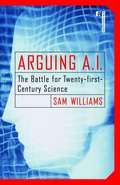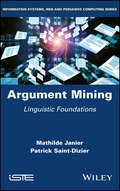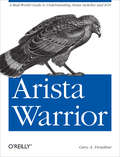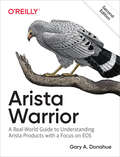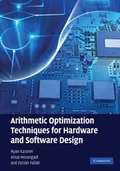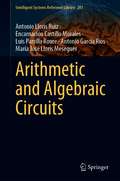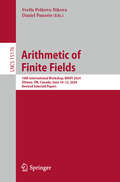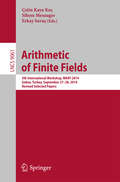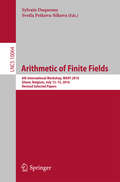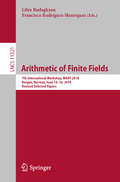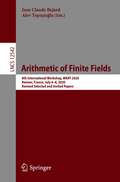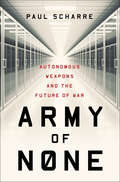- Table View
- List View
Arduino-Based Embedded Systems: Interfacing, Simulation, and LabVIEW GUI
by Rajesh Singh Sushabhan Choudhury Anita Gehlot Bhupendra SinghArduino is an open-source electronics platform based on easy-to-use hardware and software while LabVIEW is a graphical programming telling how to connect functions and work with a variety of datatypes when constructing applications.This book will help beginners to get started with Arduino-based embedded systems including essential know-how of the programming and interfacing of the devices. Book includes programming and simulation of Arduino-based projects and interfacing with LabVIEW, based on practical case studies. The book comprises of total twenty five chapters with description, working model of LabVIEW and programming with Arduino IDE.
Arduino: A Handbook for Technicians, Engineers, and Makers
by J. M. HughesRather than yet another project-based workbook, Arduino: A Technical Reference is a reference and handbook that thoroughly describes the electrical and performance aspects of an Arduino board and its software.This book brings together in one place all the information you need to get something done with Arduino. It will save you from endless web searches and digging through translations of datasheets or notes in project-based texts to find the information that corresponds to your own particular setup and question.Reference features include pinout diagrams, a discussion of the AVR microcontrollers used with Arduino boards, a look under the hood at the firmware and run-time libraries that make the Arduino unique, and extensive coverage of the various shields and add-on sensors that can be used with an Arduino. One chapter is devoted to creating a new shield from scratch.The book wraps up with detailed descriptions of three different projects: a programmable signal generator, a "smart" thermostat, and a programmable launch sequencer for model rockets. Each project highlights one or more topics that can be applied to other applications.
Arduino: A Quick-Start Guide
by Maik SchmidtArduino is an open-source platform that makes DIY electronics projects easier than ever. Gone are the days when you had to learn electronics theory and arcane programming languages before you could even get an LED to blink. Now, with this new edition of the bestsellingArduino: A Quick-Start Guide, readers with no electronics experience can create their first gadgets quickly. This book is up-to-date for the new Arduino Zero board, with step-by-step instructions for building a universal remote, a motion-sensing game controller, and many other fun, useful projects.This Quick-Start Guide is packed with fun, useful devices to create, with step-by-step instructions and photos throughout. You'll learn how to connect your Arduino to the Internet and program both client and server applications. You'll build projects such as your own motion-sensing game controller with a three-axis accelerometer, create a universal remote with an Arduino and a few cheap parts, build your own burglar alarm that emails you whenever someone's moving in your living room, build binary dice, and learn how to solder. In one of several new projects in this edition, you'll create your own video game console that you can connect to your TV set. This book is completely updated for the new Arduino Zero board and the latest advances in supporting software and tools for the Arduino. Sidebars throughout the book point you to exciting real-world projects using the Arduino, exercises extend your skills, and "What If It Doesn't Work" sections help you troubleshoot common problems. With this book, beginners can quickly join the worldwide community of hobbyists and professionals who use the Arduino to prototype and develop fun, useful inventions.What You Need:This is the full list of all parts you'd need for all projects in the book; some of these are provided as part of various kits that are available on the web, or you can purchase individually. Sources include adafruit.com, makershed.com, radioshack.com, sparkfun.com, and mouser.com. Please note we do not support or endorse any of these vendors, but we list them here as aconvenience for you. Arduino Zero (or Uno or Duemilanove or Diecimila) board USB cable Half-size breadboard Pack of LEDs (at least 3, 10 or more is a good idea) Pack of 100 ohm, 10k ohm, and 1k ohm resistors Four pushbuttons Breadboard jumper wire / connector wire Parallax Ping))) sensor Passive Infrared sensor An infrared LED A 5V servo motor Analog Devices TMP36 temperature sensor ADXL335 accelerometer breakout board 6 pin 0.1" standard header (might be included with the ADXL335) Nintendo Nunchuk Controller Arduino Ethernet shield Arduino Proto shield and a tiny breadboard (optional but recommended) Piezo speaker/buzzer (optional) Tilt sensor (optional) A 25-30 Watts soldering iron with a tip (preferrably 1/16") A soldering stand and a sponge A standard 60/40 solder (rosin-core) spool for electronics work
Arduino: Building exciting LED based projects and espionage devices
by Marco Schwartz Samarth Shah Utsav Shah Adith Jagdish BoloorFind out how to transform your Arduino device into an awesome secret agent gadget with this course, taking in everything from robotics to remote control cameras About This Book *This course won't just teach you. It will help you apply your knowledge so you can get creative - quickly! *Find out how to make a computer interact with the real-world - you'll be learning the basics of IoT without realizing it. *Robots. A sound controlled Christmas tree. This course proves anything is possible with an Arduino! Who This Book Is For Seeking inspiration? This course will help you get creative with your Arduino quickly. What You Will Learn *Find out how to explore the full potential of your tiny Arduino *Find out how to bridge the gap between the real world and software, as you gather and visualize data from the environment *Create simple servers to allow communication to occur *Transform your Arduino into a GPS tracker *Use the Arduino to monitor top secret data *Build a complete spy robot! In Detail An Arduino might be a tiny computer but it can be used as the foundation for a huge range of projects. In this course, we'll show you how just some of the projects that are possible with an Arduino. From robotics to secret agent gadgets, we're pretty confident that this course will get you thinking creatively - and inspire you to create your very own new projects using the Arduino hacking skills you learn. This course, combines both text and video content - it's made up of three modules to help organize your learning. In the first module we'll show you how to build three different Arduino projects. All of these will not only get you up and running with something practical, they'll also help you better understand how the Arduino works. Find out how to develop a home automation system and even build a robot! In the second module we'll go one step further to help you get creative as you learn how to program LEDs with your Arduino. You'll find out how to build a mood lamp and a remote-controlled TV backlight, before going on to make a sound controlled LED Christmas tree that makes use of sound visualization. Finally, the third module takes you from stylish design into espionage, as you learn how to create neat secret agent gadgets with your Arduino. Find out how to build an alarm system, a fingerprint sensor, even open a lock with a text message. And that's not all - but to find out more you'll have to dive in! This Learning Path combines some of the best that Packt has to offer in one complete, curated package. It includes content from the following Packt products: ? Arduino By Example by Adith Jagadish Boloor ? Arduino BLINK Blueprints by Samarth Shah, Utsav Shah ? Arduino for Secret Agents by Marco Shwartz Style and approach Combining both video and text and built from some of Packt's very best Arduino content, this course comprises of three modules covering a range of projects. It's completely focused on helping the user get creative as quickly as possible so they can explore what's possible with Arduino themselves.
Are U.S. Military Interventions Contagious over Time?: Intervention Timing and Its Implications for Force Planning
by Jennifer KavanaghCurrent DoD force planning processes assume that U. S. military interventions are serially independent over time. This report challenges this assumption, arguing that interventions occur in temporally dependent clusters in which the likelihood of an intervention depends on interventions in the recent past. The author used data on 66 U. S. Army contingency and peacekeeping deployments of at least company size between 1949 and 2010 and found evidence of temporal dependence between military interventions even when controlling for political, economic, and other security factors. However, the results also suggested that clustering is affected by the nature of the geopolitical regime and is stronger at certain points than others, for example, after the Cold War as compared to during the Cold War. The results suggested that as few as two military interventions above average is often enough to trigger interventions in subsequent years. Because current planning processes address only the direct force demands of a given deployment and ignore the heightened risk for additional demands created by temporal dependence, these processes may project force requirements that understate the demands placed on military deployments during a period of clustered interventions. This analysis suggests that DoD should consider modifying the integrated security constructs to incorporate serial correlation of interventions, making assumptions about the nature of the current or future geopolitical regime explicit, and assessing whether the existing set of force planning frameworks reflects the spectrum of potential future geopolitical regimes. Book jacket.
Are You My Uber?: A Parody
by Sarah Amelia DooleyWe've all been there. You call an Uber. The app says it has arrived, but . . . where is it? Where is your Uber?Are You My Uber? is a 21st Century parody of the 1960 P.D. Eastman children's book Are You My Mother? A man steps off the midnight bus at Port Authority. His name? Unknown. His goal? To find his Uber, an elusive Ford Taurus. Lost and alone in a new city, he steels himself and begins by passing right by the very object of his search. Hilarity ensues: the man proceeds to knock at the doors of an off-duty cab, a helicopter, a halal cart, and other vehicles increasing in their absurdity, willing to try anything to find his Uber.Paired with illustrations by Hilary Fitzgerald Campbell, co-illustrator of Feminist Fight Club, Sarah Dooley's hilarious imagined story is as ridiculous as it is relatable.
Are Your Bits Flipped?
by Joe KissellJust as a single flipped bit in a piece of computer code can bring an otherwise reliable app crashing to a halt, a single misconception in your understanding of personal computing technology can cause all manner of problems. Join tech expert Joe Kissell as he untangles common confusions surrounding the digital products and services we all rely on every day.
Are Your Bits Flipped?: Overcoming Tech Misconceptions
by Joe KissellOvercoming Tech MisconceptionsJust as a single "flipped bit" in a piece of computer code can bring an otherwise reliable app crashing to a halt, a single misconception in your understanding of personal computing technology can cause all manner of problems -- including lost data, wasted time, and constant frustration as you live and work in today's increasingly digital world. In this unique title from Take Control, which is packed with little-known facts and debunked beliefs, tech expert Joe Kissell untangles common confusions surrounding the high-tech products and services we all rely on every day.By eliminating your tech misconceptions, you'll:Avoid common errors that waste precious time or result in data loss.Make decisions based on an accurate understanding of how things work.Find yourself asking for -- or paying for! -- computer help less often.Have clear explanations on hand when others ask you for help.Better understand tech topics in the headlines -- encryption, passwords, privacy, and more.Make a stronger impression at a job interview, user group, or wherever your tech skills may be judged.Some of the 16 chapters in this 190-page book are updated and expanded versions of essays originally published in TidBITS.You'll start thinking more clearly about:Trust: Can you trust an online service like iCloud or Gmail, or a password manager?Privacy: How do you evaluate your privacy when a Web site wants you to give it personal information? What if the site wants to track the way you use it? What if you want to store confidential data on it?Fear: Should you worry about using Java or JavaScript, two computer languages that have little in common except their names?Clicking: Why click twice when you can click once? Sort out once and for all what a single click versus a double click can accomplish rather than just clicking randomly like a teenager.Opening apps: Are you in the shockingly large group of people who spend too much time on the mundane action of opening apps?Cloud accumulation: How many cloud services (like Dropbox or Google Drive) do you need, where are your "cloud" files actually kept, and how can you keep your monthly cost down?Email: How can you ensure that attachments make it through? Do you worry about where your email is actually located? Did you know you can choose an email address that will work over time and make you look better online?Backups: Are you relying on a backup strategy that will let you down? Should you worry about what happens if you start up your Mac from a bootable duplicate?Encryption: Do you understand why the U.S. government is going after the giant tech companies, and why the stakes are high for your own use of encryption?Passwords: Do you know why it's such a bad idea to use the same password for multiple sites, or to rely on a pattern? (Please, please, use a password manager.)Web: Are your Web searches finding what you want quickly and easily? Did you know that you can navigate the Web more effectively if you understand how URLs work?Is this book for a person like me?We designed the book for people with a wide range of tech experience, from those who do little more than read email and browse the Web all the way up to people who provide technical support professionally. A few topics focus on the Mac, but the majority of the book is of general interest.
Argentina innovadora: Quiénes son los emprendedores, científicos y artistas que están cambiando el país
by Silvia Naishtat María Eugenia EstenssoroCómo hicieron los emprendedores tecnológicos que hace veinte años decidieron realizar el sueño de una nación innovadora y creativa, reconocida por su talento en el resto del mundo. En América Latina hay siete unicornios, y cuatro son argentinos. No se trata de seres mitológicos, sino de empresas tecnológicas valuadas en más de mil millones de dólares. No solo se distinguen por su valor, sino por llevar en su ADN una gran dosis de espíritu rupturista e innovador. Surgieron y se desarrollaron a contramano de la realidad local, y hoy son multinacionales que generan riqueza, trabajo de calidad y crecimiento sostenido. Mercado Libre es la principal plataforma de comercio electrónico de habla hispana y un caso de estudio en la Universidad de Stanford. Despegar es la quinta agencia de turismo del mundo. Globant suministra tecnología a empresas como Disney y Google. OLX está presente en ciento veinte países y es la mayor compañía de venta de clasificados por internet en la India. Pero no son casos excepcionales, y el término "unicornios" se extiende a otras empresas con las mismas características: Gran Data anticipa el comportamiento de los consumidores para las principales compañías telefónicas de los Estados Unidos; Satellogic ya lanzó cinco satélites al espacio que brindan imágenes con una resolución nunca antes alcanzada; y Bioceres posee un gen resistente a la sequía que puede permitir una nueva revolución productiva en el agro. Luego de dos años de viajes y entrevistas, María Eugenia Estenssoro y Silvia Naishtat concluyen que estos son ejemplos descollantes de que la Argentina no es solo un semillero de futbolistas de calidad internacional: con políticas públicas adecuadas, el país puede aspirar también a ser un polo mundial de innovación en áreas tan diversas como la biotecnología, el arte y la comunicación.
Argo CD in Practice: The GitOps way of managing cloud-native applications
by Liviu Costea Spiros Economakis Alexander MatyushentsevBuild CD pipelines following GitOps principles like declarative and immutable changes stored in version control, all continuously reconciled by Argo CD, and minimize the failure of deployments.Purchase of the print or Kindle book includes a free eBook in the PDF format.Key FeaturesDiscover how to apply GitOps principles to build real-world CD pipelinesUnderstand Argo CD components and how they work together to reconcile cloud native applicationsLearn to run Argo CD in production with declarative config changes, security, observability, disaster recovery, and moreBook DescriptionGitOps follows the practices of infrastructure as code (IaC), allowing developers to use their day-to-day tools and practices such as source control and pull requests to manage apps. With this book, you'll understand how to apply GitOps bootstrap clusters in a repeatable manner, build CD pipelines for cloud-native apps running on Kubernetes, and minimize the failure of deployments. You'll start by installing Argo CD in a cluster, setting up user access using single sign-on, performing declarative configuration changes, and enabling observability and disaster recovery. Once you have a production-ready setup of Argo CD, you'll explore how CD pipelines can be built using the pull method, how that increases security, and how the reconciliation process occurs when multi-cluster scenarios are involved. Next, you'll go through the common troubleshooting scenarios, from installation to day-to-day operations, and learn how performance can be improved. Later, you'll explore the tools that can be used to parse the YAML you write for deploying apps. You can then check if it is valid for new versions of Kubernetes, verify if it has any security or compliance misconfigurations, and that it follows the best practices for cloud-native apps running on Kubernetes. By the end of this book, you'll be able to build a real-world CD pipeline using Argo CD.What you will learnUnderstand GitOps principles and how they relate to IaCDiscover how Argo CD lays the foundation for reconciling Git state with the cluster stateRun Argo CD in production with an emphasis on reliability and troubleshootingBootstrap Kubernetes clusters with essential utilities following the GitOps approachSet up a CD pipeline and minimize the failure of deploymentsExplore ways to verify and validate the YAML you put together when working with KubernetesUnderstand the democratization of GitOps and how the GitOps engine will enable its further adoptionWho this book is forIf you're a software developer, DevOps engineer, or SRE who is responsible for building CD pipelines for projects running on Kubernetes and wants to advance in your career, this book is for you. Basic knowledge of Kubernetes, Helm, or Kustomize and CD pipelines will help you to get the most out of this book.
Argo CD: Up and Running
by Andrew Block Christian HernandezLearn how to manage Kubernetes clusters and application configurations with Argo CD, the easy-to-use open source GitOps engine. With this practical book, development teams will quickly gain a foundational understanding of Argo CD for deploying and managing containerized applications - without having to be a Kubernetes expert, and without needing full access to an existing Kubernetes environment.With the adoption of Kubernetes, the ability to effectively manage platform configurations has become a paramount concern. Authors Andrew Block from Red Hat and Christian Hernandez from Akuity show you how to apply GitOps practices with Argo CD to manage one or even thousands of Kubernetes environments with confidence. You'll start with a basic understanding of the Argo CD technology and quickly learn how to achieve faster and more secure deployments.With this book, you will:Learn the basics of applying GitOps principles to your Kubernetes environmentsUse Argo CD to manage Kubernetes configurations as well as the applications you deploy to the platformManage the configurations of a single Kubernetes cluster or thousands of clustersDeploy Kubernetes resources using tools such as Kustomize and HelmUnderstand the importance of managing sensitive material and resources
Arguing A.I.: The Battle for Twenty-first Century Science
by Sam WilliamsFew scientific topics since the theory of biological evolution have inspired as much controversy as artificial intelligence has. Even now, fifty years after the term first made its appearance in academic journals, many philosophers and more than a few prominent scientists and software programmers dismiss the pursuit of thinking machines as the modern-day equivalent of medieval alchemists' hunt for the philosopher's stone--a pursuit based more on faith than on skeptical inquiry. In Arguing A.I., journalist Sam Williams charts both the history of artificial intelligence from its scientific and philosophical roots and the history of the A.I. debate. He examines how and why the tenor of the debate has changed over the last half-decade in particular, as scientists are struggling to take into account the latest breakthroughs in computer science, information technology, and human biology. For every voice predicting machines like 2001's HAL within the next twenty to thirty years, others have emerged with more pessimistic forecasts. From artificial intelligence's pioneers John McCarthy and Marvin Minsky, to futurist authors Ray Kurzweil and Hans Moravec, to software architects Bill Joy and Jaron Lanier,Arguing A. I. introduces readers to the people participating in the current debate, both proponents and critics of A.I. who are changing the way computers "think" and the way we think about computers. Ultimately, Arguing A.I. is as much a history of thought as it is a history of science. Williams notes that many of the questions plaguing modern scientists and software programmers are the same questions that have concerned scientists and philosophers since time immemorial: What are the fundamental limitations of science and scientific inquiry? What is the nature of intelligence? And, most important, what does it really mean to be human?
Argument Mining: Linguistic Foundations
by Mathilde Janier Patrick Saint-DizierThis book is an introduction to the linguistic concepts of argumentation relevant for argument mining, an important research and development activity which can be viewed as a highly complex form of information retrieval, requiring high-level natural language processing technology. While the first four chapters develop the linguistic and conceptual aspects of argument expression, the last four are devoted to their application to argument mining. These chapters investigate the facets of argument annotation, as well as argument mining system architectures and evaluation. How annotations may be used to develop linguistic data and how to train learning algorithms is outlined. A simple implementation is then proposed. The book ends with an analysis of non-verbal argumentative discourse. Argument Mining is an introductory book for engineers or students of linguistics, artificial intelligence and natural language processing. Most, if not all, the concepts of argumentation crucial for argument mining are carefully introduced and illustrated in a simple manner.
Arista Warrior: A Real-World Guide to Understanding Arista Switches and EOS (Oreilly And Associate Ser.)
by Gary A. Donahue<p>A relative newcomer in the data center and cloud networking markets, Arista has recently met with considerable success. With this book, renowned consultant and technical author Gary Donahue (<i>Network Warrior</i>) provides a practical, in-depth guide to Arista’s lineup of networking hardware, as well as its underlying EOS operating system.</p>
Arista Warrior: Arista Products with a Focus on EOS (Oreilly And Associate Ser.)
by Gary A. DonahueArista Networks has become a key player when it comes to software-driven cloud networking solutions for large data center storage and computing environments. In this updated edition of Arista Warrior, renowned consultant and technical author Gary Donahue Network Arista Networks has become a key player when it comes to software-driven cloud networking solutions for large data center, storage, and computing environments, and with their continued expansion and growth since the first edition was released, this book is a welcome update. In this updated edition of Arista Warrior, renowned trainer, consultant, and technical author Gary A. Donahue (Network Warrior) provides an in-depth, objective guide to Arista’s products explains why its network switches, software products, and Extensible Operating System (EOS) are so effective.Anyone with a CCNA or equivalent knowledge will benefit from this book, especially entrenched administrators, engineers, or architects tasked with building an Arista network. Is Arista right for your network? Pick up this in-depth guide and find out.In addition to the topics covered in the first edition, this book also includes:Configuration Management: Config sessions, config replace, etc.CloudVision: Arista’s management, workload orchestration, workflow automation, configuration, and telemetry toolVXLAN: Layer-2 overlay networkingFlexRoute: Two million routes in hardwareTap Aggregation: Make your switch or blade into a Tap Aggregation deviceAdvanced Mirroring: Mirror to a port-channel or even the CPUNetwork Design: A quick overview of the Arista recommended network designsvEOS: Arista’s Extensible Operating System in a VM with step-by-step instructionscEOS: Arista’s EOS in a container with exampleseAPI: Arista’s fabulous extended Application Programmable Interface
Arithmetic Optimization Techniques for Hardware and Software Design
by Ryan Kastner Anup Hosangadi Farzan FallahObtain better system performance, lower energy consumption, and avoid hand-coding arithmetic functions with this concise guide to automated optimization techniques for hardware and software design. High-level compiler optimizations and high-speed architectures for implementing FIR filters are covered, which can improve performance in communications, signal processing, computer graphics, and cryptography. Clearly explained algorithms and illustrative examples throughout make it easy to understand the techniques and write software for their implementation. Background information on the synthesis of arithmetic expressions and computer arithmetic is also included, making the book ideal for new-comers to the subject. This is an invaluable resource for researchers, professionals, and graduate students working in system level design and automation, compilers, and VLSI CAD.
Arithmetic and Algebraic Circuits (Intelligent Systems Reference Library #201)
by Antonio Lloris Ruiz Encarnación Castillo Morales Luis Parrilla Roure Antonio García Ríos María José Lloris MeseguerThis book presents a complete and accurate study of arithmetic and algebraic circuits. The first part offers a review of all important basic concepts: it describes simple circuits for the implementation of some basic arithmetic operations; it introduces theoretical basis for residue number systems; and describes some fundamental circuits for implementing the main modular operations that will be used in the text. Moreover, the book discusses floating-point representation of real numbers and the IEEE 754 standard. The second and core part of the book offers a deep study of arithmetic circuits and specific algorithms for their implementation. It covers the CORDIC algorithm, and optimized arithmetic circuits recently developed by the authors for adders and subtractors, as well as multipliers, dividers and special functions. It describes the implementation of basic algebraic circuits, such as LFSRs and cellular automata. Finally, it offers a complete study of Galois fields, showing some exemplary applications and discussing the advantages in comparison to other methods. This dense, self-contained text provides students, researchers and engineers, with extensive knowledge on and a deep understanding of arithmetic and algebraic circuits and their implementation.
Arithmetic of Finite Fields: 10th International Workshop, WAIFI 2024, Ottawa, ON, Canada, June 10–12, 2024, Revised Selected Papers (Lecture Notes in Computer Science #15176)
by Svetla Petkova-Nikova Daniel PanarioThis book constitutes the refereed proceedings of the 10th International Workshop on Arithmetic of Finite Fields, WAIFI 2024, held in Ottawa, Ontario, Canada, during June 10–12, 2024. The 17 full papers included in this book were carefully reviewed and selected from 29 submissions. They were organized in topical sections as follows: Invited talks; Coding theory; Cryptography and Boolean functions; and Postquantum Cryptography.
Arithmetic of Finite Fields: 5th International Workshop, WAIFI 2014, Gebze, Turkey, September 27-28, 2014. Revised Selected Papers (Lecture Notes in Computer Science #9061)
by Çetin Kaya Koç Sihem Mesnager Erkay SavaşThis book constitutes the refereed proceedings of the 5th International Workshop on the Arithmetic of Finite Field, WAIFI 2014, held in Gebze, Turkey, in September 2014. The 9 revised full papers and 43 invited talks presented were carefully reviewed and selected from 27 submissions. This workshop is a forum of mathematicians, computer scientists, engineers and physicists performing research on finite field arithmetic, interested in communicating the advances in the theory, applications, and implementations of finite fields. The workshop will help to bridge the gap between the mathematical theory of finite fields and their hardware/software implementations and technical applications.
Arithmetic of Finite Fields: 6th International Workshop, WAIFI 2016, Ghent, Belgium, July 13-15, 2016, Revised Selected Papers (Lecture Notes in Computer Science #10064)
by Sylvain Duquesne and Svetla Petkova-NikovaThis book constitutes the thoroughly refereed post-workshop proceedings of the 6th International Workshop on the Arithmetic of Finite Field, WAIFI 2016, held in Ghent, Belgium, in July 2016. The 14 revised full papers and 3 invited talks presented were carefully reviewed and selected from 38 submissions. The papers are organized in topical sections on invited talks; elliptic curves; applications; irreducible polynomials; applications to cryptography; Boolean functions; cryptography; cryptography and Boolean functions.
Arithmetic of Finite Fields: 7th International Workshop, WAIFI 2018, Bergen, Norway, June 14-16, 2018, Revised Selected Papers (Lecture Notes in Computer Science #11321)
by Lilya Budaghyan Francisco Rodríguez-HenríquezThis book constitutes the thoroughly refereed post-workshop proceedings of the 7th International Workshop on the Arithmetic of Finite Field, WAIFI 2018, held in Bergen, Norway, in June 2018. The 14 revised full papers and six invited talks presented were carefully reviewed and selected from 26 submissions. The papers are organized in topical sections on invited talks; elliptic curves; hardware implementations; arithmetic and applications of finite fields and cryptography.
Arithmetic of Finite Fields: 8th International Workshop, WAIFI 2020, Rennes, France, July 6–8, 2020, Revised Selected and Invited Papers (Lecture Notes in Computer Science #12542)
by Jean Claude Bajard Alev TopuzoğluThis book constitutes the thoroughly refereed post-workshop proceedings of the 8th International Workshop on the Arithmetic of Finite Field, WAIFI 2020, held in Rennes, France in July 2020. Due to the COVID-19, the workshop was held online. The 12 revised full papers and 3 invited talks presented were carefully reviewed and selected from 22 submissions. The papers are organized in topical sections on invited talks, Finite Field Arithmetic, Coding Theory, Network Security and much more.
Arithmetic of Finite Fields: 9th International Workshop, WAIFI 2022, Chengdu, China, August 29 – September 2, 2022, Revised Selected Papers (Lecture Notes in Computer Science #13638)
by Sihem Mesnager Zhengchun ZhouThis book constitutes the thoroughly refereed post-workshop proceedings of the 8th International Workshop on the Arithmetic of Finite Field, WAIFI 2022, held in Chengdu, China, in August – September 2022.The 19 revised full papers and 3 invited talks presented were carefully reviewed and selected from 25 submissions. The papers are organized in topical sections: structures in finite fields; efficient finite field arithmetic; coding theory; cryptography; sequences.
Armament, Arms Control and Artificial Intelligence: The Janus-faced Nature of Machine Learning in the Military Realm (Studies in Peace and Security)
by Niklas Schörnig Thomas ReinholdLooking at a variety of armament sectors, the book examines how Artificial Intelligence (AI) impacts the fields of armament and arms control, how existing arms control measures will be affected by AI, and what new approaches based on AI have been or are currently developed. The significant increase in computing power, the increasing reliance on software, and the advent of (narrow) AI and deep-learning algorithms all have the potential to lead to disruptive changes for military operations and warfare, rendering many classical arms control instruments less effective, or even useless. On the other hand, AI might lead to completely new arms control approaches, raising the effectiveness and reliability of new verification measures. To provide a common understanding, the book starts by presenting a general introduction to the state of the art in artificial intelligence and arms control, and how the two topics are interrelated. The second part of the book looks at examples from various fields of weapon technology, including weapons of mass destruction (WMD), conventional armament, and emerging technologies. The final section offers a cross-cutting perspective based on the examples presented in the second part.This volume will appeal to students and scholars of international relations, as well as policy-makers and practitioners interested in a better understanding of peace and security studies in general, and armament and arms control in particular with a strong focus on AI.
Army of None: Autonomous Weapons And The Future Of War
by Paul ScharreA Pentagon defense expert and former U.S. Army Ranger explores what it would mean to give machines authority over the ultimate decision of life or death. <P><P> What happens when a Predator drone has as much autonomy as a Google car? Or when a weapon that can hunt its own targets is hacked? Although it sounds like science fiction, the technology already exists to create weapons that can attack targets without human input. Paul Scharre, a leading expert in emerging weapons technologies, draws on deep research and firsthand experience to explore how these next-generation weapons are changing warfare. <P><P> Scharre’s far-ranging investigation examines the emergence of autonomous weapons, the movement to ban them, and the legal and ethical issues surrounding their use. He spotlights artificial intelligence in military technology, spanning decades of innovation from German noise-seeking Wren torpedoes in World War II—antecedents of today’s homing missiles—to autonomous cyber weapons, submarine-hunting robot ships, and robot tank armies. Through interviews with defense experts, ethicists, psychologists, and activists, Scharre surveys what challenges might face "centaur warfighters" on future battlefields, which will combine human and machine cognition. We’ve made tremendous technological progress in the past few decades, but we have also glimpsed the terrifying mishaps that can result from complex automated systems—such as when advanced F-22 fighter jets experienced a computer meltdown the first time they flew over the International Date Line. <P><P>At least thirty countries already have defensive autonomous weapons that operate under human supervision. Around the globe, militaries are racing to build robotic weapons with increasing autonomy. The ethical questions within this book grow more pressing each day. To what extent should such technologies be advanced? And if responsible democracies ban them, would that stop rogue regimes from taking advantage? At the forefront of a game-changing debate, Army of None engages military history, global policy, and cutting-edge science to argue that we must embrace technology where it can make war more precise and humane, but without surrendering human judgment. When the choice is life or death, there is no replacement for the human heart.
